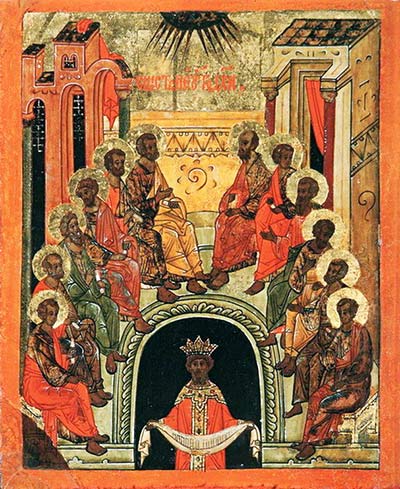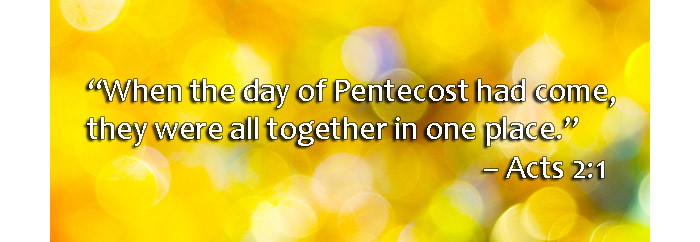«When the day of Pentecost arrived, they were all together in one place. And suddenly there came from heaven a sound like a mighty rushing wind, and it filled the entire house where they were sitting. And divided tongues as of fire appeared to them and rested on each one of them. And they were all filled with the Holy Spirit and began to speak in other tongues as the Spirit gave them utterance.»
Acts 2:1-4
The New Testament account of Pentecost is depicted by Luke, the author of the Acts of the Apostles, (who, according to what we know in Luke 1:3, carefully researched all the events he writes about.) Apart from that written narration, we have seen many paintings depicting the scene of Pentecost from Christian artists throughout history.
Among those paintings, perhaps the least known in the Western world, are the Greek or Russian Pentecost Icons, which follow a pattern established by iconographic rules and, therefore, are all very similar. What can be difficult to grasp for us westerners is the fact that eastern icons do not pretend to represent reality. They are not portraits, but rather intend to communicate certain spiritual realities through those conventional spiritual canons. This is why the critical comments I make here barely apply to these icons.

The classical Pentecost icon shows the twelve apostles (the twelfth one being Matthias, of course) “sitting”, as the passage suggests, in a semi-circular bench, with tongues of fire over their heads and other symbols seeking to represent the light of the Spirit and the world to which they must bring the Gospel. Catholics from the west will immediately notice the absence of the Virgin Mary, who is always present in the Catholic paintings.
Western representations, that don’t follow any rule but the artist’s imagination and his intention to refer to the biblical account, generally show the twelve apostles, in various attitudes and postures and with the tongues of fire, but invariably with the Virgin Mary who is generally in the middle of the group and often at a higher level.
A different representation that I saw about a year ago was not a painting, but part of a Christian movie of a series that ‘supposedly’ attempts to be faithful to the biblical account. In this scene the apostles are gathered in a living room standing together with the Virgin Mary and Mary Magdalene. Following what is said in the first chapter of Acts, they were praying and incessantly repeating the Lord’s Prayer. (According to the creators of this movie, the only prayer the early Christians would say was this one, and to pray a lot, would mean they would repeat it many times). An interesting visual effect (possibly the only merit of this film footage) the tongues of fire appear over them… They immediately leave the house, dispersing each in their own way. They begin to talk to people that they meet along the road, speaking in various languages…
Well, as you might have noticed, in my own judgment I think this film’s account is what I consider to be the worst I have seen. But I will not analyze it directly. I will, instead, take the passage from Acts in its context and pull some details from it that help me, personally, to create some sort of mental picture of the Pentecost occurrences. Some criticism of the western pictorial representations as well as the film version mentioned above will sprout indirectly.
Analysis of Luke’s depiction of Pentecost
My main thesis is that the account of Acts, especially if we consider its literary and cultural context, is sufficiently clear and abundant in details to allow oneself to form a mental image of the first Pentecost, and that if painters and filmmakers simply kept to the account, the resulting works would be very different from the ones we currently have.
To be able to understand the passage of Acts 2:1-4, written above, we must overall consider the first chapter of Acts. This chapter can be divided into three sections: (a) vv. 1-11: an account of the Ascension of Jesus, including references to the Risen Lord’s appearances over those forty days, his promise of the Holy Spirit and Luke’s version of the missionary commission; (b) vv. 12-14: a brief description of what the apostles did after the ascension, and the first days of prayer together with many women and other disciples of Jesus; and (c) vv. 15-26: the account of the election of Matthias, to complete the number of the twelve apostles.
They devoted themselves to prayer in the upper room
We can pull out some interesting details from the second and third sections of the first chapter. First of all, that immediately after the Ascension it says (1:13) that they went to the “upper room” where the eleven apostles were staying, and there “with one accord they devoted themselves to prayer together with the women and Mary the mother of Jesus and his brothers”. The “upper room” was possibly the same where Jesus celebrated his last supper and was a big enough room to allow for such a number of people. It is true that v.13 mentions the apostles by name, and then mentions that they were there with “the women” (which could refer, at least partially, to the wives of those who were married; and/or the numerous women who – according to Luke 8:2-3, 23:49,55 – had accompanied Jesus from Galilee), and specifically “Mary, the mother of Jesus”. This way of referring to Mary, surely recognizes special importance in Mary, not including her among “the women” but pointing her out. Then it also mentions that “his brothers” were also there: even though we will not consider which exactly was their family bond with Jesus, the fact is that there were other men in the group, apart from the apostles.
Verse 14 also says that they “devoted themselves to prayer”. This means that they prayed together as a group. It isn’t likely that it means that they spent all their time praying because they at least had to eat, sleep, buy food and, without a doubt, go to the Temple at certain times of the day. But it does mean that they prayed together regularly and “with one accord”. What did they do or say when praying? Since they were all Jewish, they were very likely praying the Psalms and other passages from Scripture. They were also disciples of Jesus so it is probable that they indeed prayed the Lord’s Prayer that they heard from Jesus’ mouth. However, it is not at all likely that they repeated the Lord’s Prayer as a magical or mechanical formula.
Without a doubt they had spontaneous prayers as well, as we see in Chapter 1 of Acts (vv. 24-25), before the election of Mathias; and also, further ahead, in 4:24-30, when they pray in the midst of persecution. It is likely that in their spontaneous prayers they asked God to fulfill his promise of the Holy Spirit who would “baptize” them and fill them with power for mission (1:4-5,8). Certainly, these prayers were done aloud; when they included psalms, these were sung or whispered in a low audible voice. The prayer of that first Christian group was certainly not silent or purely interior prayer.
120 were gathered together with the twelve apostles
Precisely after that, when narrating the election of Matthias to the number of the apostles, it says in Acts 1:15 that Peter “stood up among the brothers (the company [literally a multitude] of persons was in all about 120.” Were those one hundred and twenty all gathered in the “upper room”? It doesn’t specify but we could suppose they did, because it says that they were “in the same place” (or “in one same place”) Now then, the “one hundred and twenty” could only be the men, because it was a decision-making assembly (to decide who should replace Judas Iscariot); and in that time it was considered that men, as head of the family, were enough to represent their family; not because women were discredited, but because that was the way society was built. If that were the case, there were really much more than 120 once the women are accounted for; but if not, we know that there were at least one hundred and twenty.
Very soon later, at the beginning of Chapter 2, it says in verse 1 that “When the day of Pentecost arrived, they were all together in one place”. “(“Pentecost” was the Greek name of the Jewish feast of the weeks [Hebrew Shavuot], that they still celebrate 50 days after Passover.) It tells us that “they were all together”. Who are “all”? The most reasonable is that it refers to the whole group of the one hundred and twenty, which is the most recently mentioned number, but including “the women and Mary the mother of Jesus”, since it refers to those who were “devoting themselves to prayer” waiting for the fulfillment of Jesus’ promise. And they were “in the same place” or “in one same place” (the Greek phrase could also mean “with one purpose” but it’s the least likely because it is the same phrase used in 1:15 where it clearly refers to the place they were). What was that place? The upper room? Probably yes, and if that were the case, it must have been a very ample room.
Imagining the scene of 120 men and women (or more) being filled with the Holy Spirit
With all this information our scenario is a bit clearer of who they were and how “all” were when the Holy Spirit descended on Pentecost day. First of all, we can imagine a big room, in the house of a disciple on good standing (the same where Jesus had his disciples to prepare the Passover dinner at). Was this the house of Mary the mother of Mark, which is later mentioned as a gathering place for Christians in Jerusalem? It is possible. Anyway, v.2 says that the rushing wind “filled the whole house” and not only the upper room.
So, there were a hundred and twenty gathered there, or more: the initial group of Jesus’ disciples including, clearly, the Twelve, but also the “seventy two” among which Matthias and Joseph Barsabbas as possible substitutes for Judas (1:23); and “the women” – whose number we don’t know” – and especially Mary the mother of Jesus, and also the “brothers” of Jesus. That was the group over which the Holy Spirit descended; that was the incipient Church. It wasn’t only the apostles. And the Virgin Mary wasn’t the only woman, but there were others, probably many.
The text in v.2 literally says that they were “sitting¨”; but that doesn’t necessarily mean that was their corporal posture, it could only mean that they were together. In any case, they were praying. (If they prayed the Lord’s Prayer, I doubt that they said it more than once. From the beginning, Christian worship during the Lord’s Day included, as today, the corporate prayer of the Lord’s Prayer, but only once). It is likely that being a mixed group, the men were on one side of the room, and women on the other side as was the Jewish tradition and still is. This was the tradition for a few centuries also among Christians. Was the Virgin Mary sitting in front or in the middle, or in a special seat? Of course not! The meeting was presided by the apostles, probably Peter; she was with the rest of the women. The passage of 1:14 shows that she was honored in a special way, but that wouldn’t give her any directive role in the community.
So now we have various details of this stage: a big room with a large group of at least one hundred and twenty persons; all praying with certain noise or whisper; the men on one side and the women on the other, with Mary; Peter and the apostles presiding the meeting, around nine in the morning (the “third hours”, Acts 2:15), which was one of the prayer hours of the Jews (when the morning sacrifice was offered at the Temple). And in the midst of that praying noise “suddenly there came from heaven a sound like a mighty rushing wind” (v.2): this means that a very loud noise overcame the prayer noise. I wonder how many decibels. And it was then that they could all see the flames or “tongues” of fire over the heads of everyone else in the room. And they were all filled with the Holy Spirit and began to speak in other tongues (or “in different tongues”) according to v.4.
A very loud event
The noise of the Spirit and what those present were saying in different tongues had to be loud enough to generate a curious reaction among those in the neighboring streets (the Jewish of the diaspora who had come to Jerusalem for the feast of Pentecost): it says in v.6 that “at this sound the multitude came together, and they were bewildered, because each one was hearing them speak in his own language.” And what were they saying? We hear them telling in our own tongues the mighty works of God! (Acts 2:11). They were shouting out their praises to God, and doing so not in Aramaic or Hebrew, but in the languages of the countries of which those pilgrims were coming. (This indicated that this probably was not the gift of “speaking in tongues” as described in 1 Corinthians 12:10, but rather the particular human languages of those standing by. But that topic is for another time).
With that, our scene is almost complete. Not only was it a large group of men and women who were praying, presided by the apostles, but it was also a very loud event, powerful enough to gather a crowd of people from the neighboring streets. When the multitude arrived, the Christians saw the need to address the crowd and explain what was happening, which Peter did in his famous (and improvised) sermon of that day. It was a proclamation of the good news of Jesus, who died, rose again, and was glorified, and who was now pouring out on his own disciples the power of the Holy Spirit, and (fulfilling the prophecy of Joel 2:17-21) by making the gift of the Holy Spirit available to all human beings from that moment on.
The scene as described by Luke is very far from the typical pictorial representations that have been made of it, and also certainly of its unfortunate version in the film which I mentioned earlier. When I read over and contemplate the account of Acts 2, I am more convinced that people who in the 20thand 21st centuries have experienced and been part of the Pentecostal and Charismatic movements are the ones who can more easily identify to what evidently happened on that Pentecost day. It was not a silent inner and mystical experience of a small group of twelve apostles seated around the Virgin Mary – it more likely resembled one of those powerful and loud prayer meetings that many of us experience in times of charismatic worship together.
This presentation, which was first posted on the Sword of the Spirit website, was adapted from the original essay written in Spanish by Carlos Alonso Vargas and published on his blog
Image credit: A typical traditional icon of the Pentecost in the Orthodox tradition, painted by a Russian 16th century artist. This image Is in the Public Domain. The scene depicts the Descent of the Holy Spirit on the twelve Apostles who represent all the disciples of Jesus. At the bottom is an allegorical figure, called Kosmos, which symbolizes the world.
Carlos Alonso Vargas is a long-time leader in The Sword of the Spirit, who has served mainly in teaching and community building. With studies in philology and linguistics, he works as a translator and editor. He and his wife Dora have three adult children and five grandchildren and live in San José, Costa Rica.



